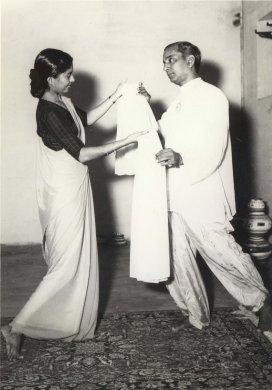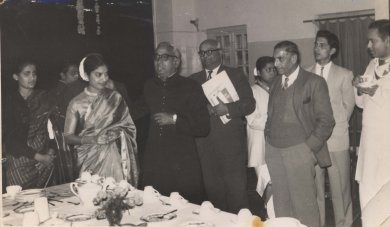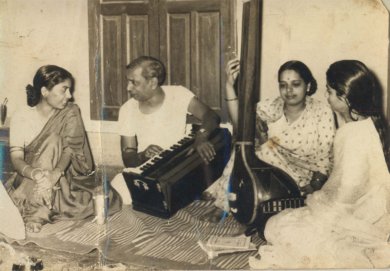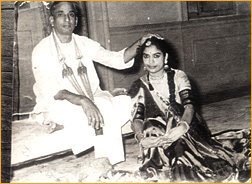Narthaki

News

Info

Featured

 |
  |
Guru Shambhu Maharaj - Dr. Maya Rao e-mail: stemdance@hotmail.com Photos: Govind Vidyarthi June 10, 2014 (This article first appeared in the Illustrated Weekly of India dated May 27, 1962) January 14, 1955: the day I was to commence my training under Guru Shambhu Maharaj, the greatest living exponent of Kathak. I was awaiting his arrival at the Akademi with mixed feelings of delight and anxiety. At 10am sharp a dark, handsome person clad in a sherwani and churidar outfit walked in, wafting the fragrance of attar. The scent of roses! How very reminiscent of the Moghul courts, I thought, and would have wandered on the wings of fancy to the setting of the romantic Moghul gardens but for the rude jerk I got when he said dryly, "Is this the student from the South who has come to receive training under me? I must say she has disturbed our old family setting and made me travel so far. Women are the same the world over." Not knowing why he talked in an accusing tone, I stood up meekly, folding my hands in a namaskar, for I guessed who he was. That was my first meeting with Shambhu Maharaj. Without waiting for any formal introduction he turned to me and said: "Listen, Maya, I am in my fifties now, and never before have I worked in an institution as an employee. Now I am to work in Bharatiya Kala Kendra. And, what is worse, this letter in a huge envelope from the Government thrusts a great responsibility on my shoulders. It says I have been chosen to impart training to Government of Indian scholars such as you, who want to specialize in the art of Kathak. The result is I have had to leave my ancestral home in Lucknow and come here to start a new life." I mustered courage to reply: "Maharaj, I have also come all the way from my home in Bangalore just to study under you. I did not know really that I was disturbing the peace of your retired life..." Patting me with paternal tenderness, he said: "No, my child, I am not annoyed. I felt sad to leave my people behind, so I had to scold someone. But, now I see that you are also in the same position and are willing to put up with difficulties for the sake of art. But remember one point always: I do not believe in the professor-student attitude of a college. I would rather you treat me as a guru." I wanted to correct his impression but did not dare to lose the sympathy I had just won. While we were talking he asked me where I had received my previous training and once again flared up when he heard that I had undergone training in the Jaipur style of Kathak. Born and brought up in the Lucknow gharana, Shambhu Maharaj does not acknowledge the greatness of any other style but his own. "So I shall have a tough time teaching you," he remarked, "as I will have to work like a sculptor who re-moulds statues, but my implements are so delicate, they are meant for ivory and not iron." Fortunately for me, he revised his opinion when he saw me dancing the next day and even complimented me on my rendering of Kathak. I was thrilled even more when, a few days later, he chose me to partner him in one of his dance items. I was hesitant to dance with him, but he gave me all assurance saying: "Maya, you look at me for guidance while dancing, I shall look at you for inspiration and God will look after both of us!" So it was, and the recital was a success. Since then I have danced many times with him, a distinction which I shall always cherish.  Maharaj showing the nuances of the 'Ghunghat' to Maya Thus I met Shambhu Maharaj and spent several years with him, learning and working with him. Yet, I still marvel at his many-sided personality. Though, in the beginning I had many misgivings about studying under him, I have never found another teacher more sensitive and indulgent almost to the point of pampering his students. Shambhu Maharaj is today the distinguished holder of the country's most coveted honors - The Sangeet Natak Akademi award and the President's award. Still he is unaffected by success and is never tired of repeating that he owes his position to his brother Guru Achan Maharaj. At the Akademi Awards function Maharaj was seen in one of his glorious outfits - kinkhab achakan and chudidar pyjama - highlighted by diamond earrings and extra rings on his usually bejeweled fingers! But he was not his usual jovial self. He was silent with a melancholic face, till he went up to the dais and received his sanad and other honours. Then he retired to a corner of the dressing-room, opened the scroll, after touching his ears in reverence. And then, suddenly he burst out laughing to the astonishment of his admirers around: "The predictions of my brother and my uncle have come true. I wish they were here to share the honour." Saying this he recalled his early period of training. Youngest of the reputed trio of Lucknow gharana - comprising besides himself, Achan Maharaj and Lachu Maharaj - Shambhu was initiated into the art when he was 8 years old by his uncle, the celebrated Bindadin. After imparting training to Shambhu for 6 months, Bindadin passed away entrusting him to Achan Maharaj's care, saying, "This boy has great promise. Impart your full knowledge to him and he will bring credit to our gharana...." Accordingly Shambhu Maharaj was trained for a few years by Achan. "I know, as far as the art of dance was concerned, I was progressing very well under the inspired guidance of my brother." Shambhu Maharaj continued, "But I could not say the same of my studies..." He was not good in English for which he was being given special lessons at home. "I must have exasperated the teacher beyond measure," he said, "for even after a month's intensive coaching I was not sure whether I should say the bird laid a nest!" He added: "Both I believe are far from correct!" Naturally he was punished mercilessly by the teacher, till Achan Maharaj intervened and rescued him. "Don't maim my brother's arm," he told the tutor. "He may not know English but he will definitely bring honor to our family." Shambhu Maharaj was happy to pay tribute to his brother's understanding. "The sanad in my hands now is thus really an honour to my uncle and my brother, but little do I know what it says..." On his request one of us explained to Maharaj the contents of the citation which named him as "the foremost exponent of Kathak." Hearing the praise for his technique in executing intricate parans and bols, Maharaj once again touched his ears and recounted another incident. In the midst of his early training there was a time of financial crisis which threatened a near disintegration of the family. Achan Maharaj had to accept a job as a court dancer in Rampur. So he went away leaving Shambhu and their mother to look after the house in Lucknow. Having no one to supervise his practice Maharaj's interests strayed. He was very keen on studying music, so he started learning thumri and khayal from Ustad Rahimuddin, a reputed musician of the time. As Maharaj had a passion for music he attained proficiency in the art in such a short period that his Ustad advised him to give up dancing and devote all his time to music. This advice alarmed Maharaj's mother who was very conscientious about maintaining the tradition of the gharana. She promptly took Shambhu to Rampur and placed him again under Achan's care, saying: "Your brother wants to become a musician. Have you heard of a worse sacrilege to our tradition? Begin his dance training today." So Shambhu started learning again, but his heart was in the thumris much to the displeasure of his mother and brother. Finally, they arranged a dance recital before a select audience at Achan's house, in which all his disciples were presented and Shambhu was to be the star-dancer. The programme started well, the students gave a brilliant exposition of the parans and bols and were highly applauded. But Shambhu was sulky; he was thoroughly at a loss as to what he should dance. All his store of tukras and parans was exhausted by the students and when his turn came Shambhu could hardly dance one or two items which were novel and not performed earlier. How could he dance more when he had not learnt much inspite of the zeal with which his brother had taught him? Realizing his folly he ran away from the stage to crave the pardon of his mother and brother and vowed that he would practice for six to eight hours a day and never again cause them anxiety. With tears in his eyes Maharaj confessed: "It was during that period of rigorous training that I resolved to perfect each tukra and paran to the complete satisfaction of my Guru Achan Maharaj. I can remember even now his smile of appreciation at my efforts." Finishing this story, Maharaj went up to the stage to give one of the most inspiring performances I have seen. Watching the clarity of his style and liquid movements one could see how many years of practice he should have put in ever since he was launched on his dancing career by Achan Maharaj. Shambhu Maharaj has given over a thousand performances to date. Long ago, in 1936, he was honoured with the title of Nritya Samrat at conference held in Dehra Dun. To Maharaj the most memorable performances of his career are those when he danced with Achan Maharaj. Achan and Shambhu have been acclaimed as "a pair yet unmatched in delineating the intricacies of nritta and nritya aspects of Kathak."  Maharaj at Maya's reception on the eve of her departure to Russia for her post grad in Choreography  Thumri sessions Master of abhinaya Speaking of abhinaya in which Shambhu Maharaj is yet unrivalled, he says that he had watched Bindadin and his disciples performing abhinaya standing. While Shambhu was intrigued with the subtle variations in bhav (expression), he felt that the variations in music were not developed fully. So, when he learnt music he paid special attention to the melodious patterns one can create in singing a certain line of a thumri and then render them in bhav. Hence he chose to sit and perform abhinaya as he could get more clarity in expressive movements and develop them with unhurried ease. Thus, in course of time, Shambhu Maharaj developed a style of his own in abhinaya. Before starting on abhinaya, Maharaj sits on the dais and sings the thumri for a few minutes and then chooses one line from it for interpretation. He is then free to explore the beauty so as to employ his unlimited imagination to interpret each word of the song. One of Maharaj's favourite thumris is Shyam ghunghat pat khole (Shyam forcefully lifts my veil). I have seen him perform this over twenty times, but as yet Maharaj has not exhausted his vocabulary in portraying the idea of the first line itself. Every time he seems to tell different tales out of a single musical phrase. He stresses each word and gives a poetic interpretation to it with amazing vividness. For instance, Shyam is described as Krishna the dark-hued God whose amorous sport is recreated in Brindavan. Again Shyam is associated with the dark blue clouds which play hide and seek with moon, Shyam is charm to her life. As a gopi applies surma to her eyes. Yet, there is a thrill which makes her open her eyes. The thrill of the smarting surma is compared with the thrill a gopi enjoys when Krishna pulls her veil. Thus Maharaj delves deep into poetry with his facial expressions, in which his eyes especially become eloquent. Expressions of joy, desire, annoyance, coquettish invitation and the like are rendered in such quick succession that one cannot help marvel at his superb command in this field. No wonder he was honoured as Abhinaya Chakravarti at the Experts Committee Session held by the Music Academy in Madras, 1958, immediately after an exquisite performance by him. While talking of Maharaj's contribution to abhinaya, Balasaraswati, another great exponent, remarked: "The alternating expressions of happiness, longing, despair and hope of a gopi are rendered by Maharaj in such delicate gestures and spontaneous facial expression that I feel like sitting next to him to learn afresh."  Blessing his favourite disciple Shambhu Maharaj is not only a renowned dancer but a reputed guru also. He can be easily identified with the ideal dancer and dance teacher immortalized by Kalidasa in his Malavikagnimitra. Most of the leading Kathak dancers of the younger generation are the disciples of Maharaj. He works very hard with his students endeavoring to leave the stamp of his style on them. He aims at perfection in every step and movement. He is forever creating new dance sequences emphasizing the lyrical aspect. He never lets his student leave the class until he is assured that he or she is able to perform a new lesson with confidence. Maharaj is a great favorite with his students and friends. Being a man of varied moods and endowed with a fine sense of humour, his visit each day to the college has a novelty of its own. On a warm day it is refreshing to see him in a happy mood flaunting his new Lucknow kurta, saying, with a twinkle in his eyes, "It is a gift from one of my admirers!" Another day he would walk in, singing one of his favourite thumris, eager to perform it the moment he enters the class. A connoisseur of beauty, he has a ghazal or couplet ready when he sees any of his girl students looking charming in a colourful sari. Yet, there are times too when the students hide from him. That is when Maharaj is in a temper. At that time even a slight mistake is enough to annoy him and make him shout a volley of abuses. When news goes round that Maharaj is in one of those dark moods, one of the students comes prepared with a pathetic tale about an uncle's illness or grandfather's fractured leg. Such tales of human suffering melt Maharaj's heart. He will not only disperse the class for a few minutes but join in the grief of the student. Personally, I would always like to see Maharaj in one of his hilarious moods, when he sails into the class with the breeze wafting the fragrance of attar, and the spontaneous smile on his lips promises a ghazal of sweet melody. Kathak Guru Dr. Maya Rao is the Director of Natya Institute of Kathak and Choreography, Bangalore. Post your comments Please provide your name and email id along with your comment. All appropriate comments posted with name and email id in the blog will also be featured in the site. |